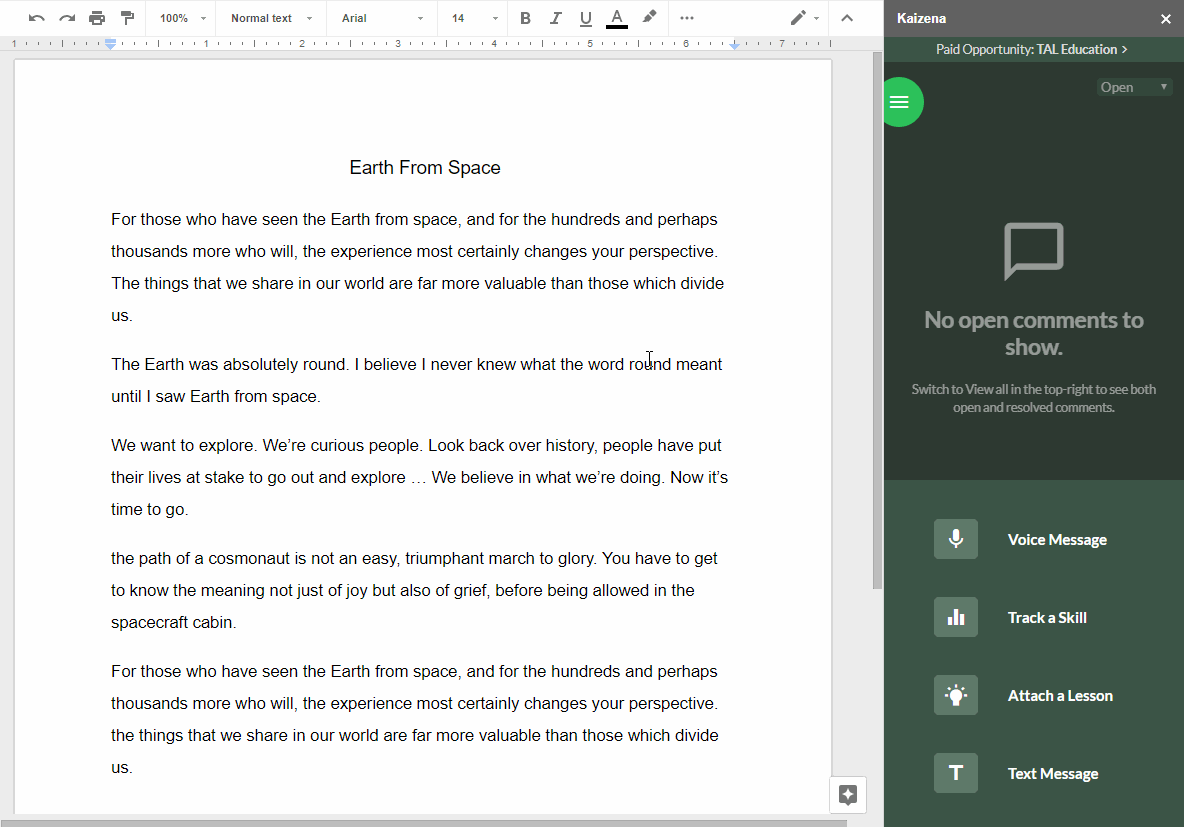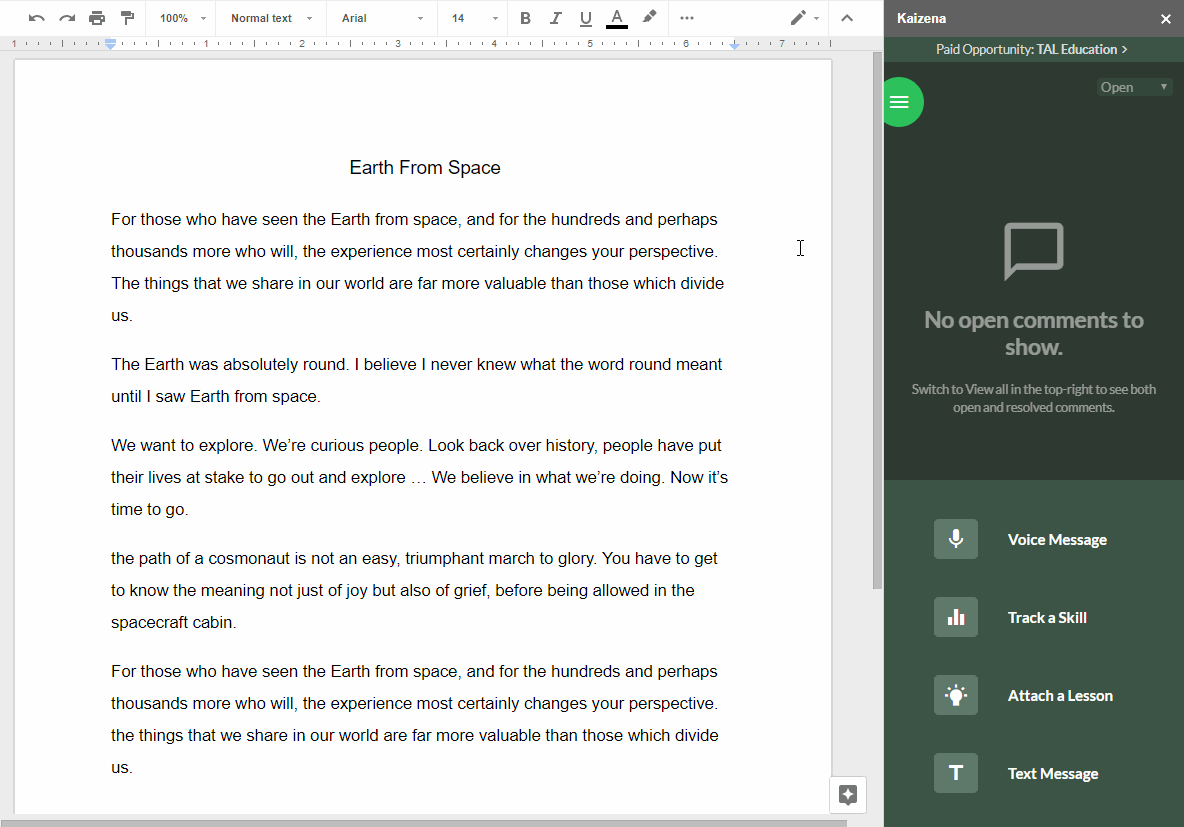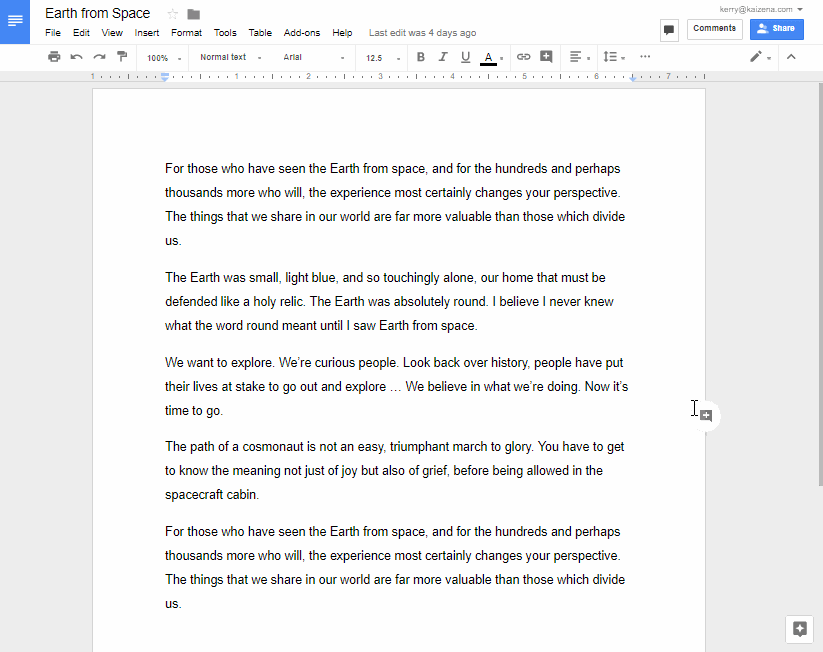Streamlining the Feedback Process with Kaizena — A Google Docs Add-On

This Digital Tool is licensed under a Creative Commons Attribution-Non commercial 4.0 International License.
Whenever a teacher manages to make the way they provide feedback more effective, the ultimate winners are their students, who benefit from more precise and more timely comments on their assignments. Kaizena is a free Google add-on and web app that simplifies and streamlines providing feedback in the form of audio, text or video.
What Does it Do?
Based on feedback approaches previously covered on Profweb, Kaizena has the merit of bringing together these functionalities in an intuitive and easy-to-use environment free from unnecessary bells and whistles:
More specifically, Kaizena is designed around 3 principles:
- Commenting on a specific assignment
- Assessing and tracking skills demonstrated in the assignment
- Sharing lessons that allow students to review the aspect(s) they struggle with
Kaizena integrates with Google Docs as an add-on, so you can insert text, audio and video without leaving the student’s document. The web app allows you to create:
- Groups for easier student management
- Rubrics for skills tracking
- Lessons based on self-produced or online content
These functions are explained in the sections below.
Setting Up
Since Kaizena functions within Google Docs, you can easily set it up using your Google credentials:
- First, install the add-in by clicking the Add-ons tab from the top menu in Google Docs and selecting Get Add-ons. Type “Kaizena” in the Search field.
- Once installed, click the Add-ons tab again and select Kaizena. Upon first use, as a teacher, you will be asked to enter a few details about your affiliation and the level at which you teach to create an account. You can then also access the teacher control panel through the web app with your Google account credentials.
- Students also need to install the add-on, but they do not need to create a Kaizena account. If you are not using Google Classroom, your students will need to give you editing permissions for their document to allow you to leave feedback with Kaizena. Afterwards, they gain immediate access to their teacher’s feedback on their Google Doc when they open the add-on.

The Kaizena add-on opens a new pane on the right-hand side of the screen. From there, teachers and students can create and access feedback.
How-to: Commenting
To add a voice comment:
- Highlight a word or passage in the document. Different colours are available, which allows you to categorize types of errors or types of comments.
- Click the microphone button labelled Voice Message. Upon first use, you may need to click Allow in the pop-up window to give Kaizena access to your microphone.
- Record your voice comment, which can be up to 30 seconds long. A paid pro version is available, and allows comments of up to 10 minutes each.
- Click Stop and Post to automatically insert your audio comment. Click the exit (X) button to cancel your comment or start over.
Text comments can be inserted in a similar manner, by clicking the letter button labelled Text Message after highlighting a passage in the document.
The same text and audio commenting tools are available to students. This way, they can reply to teacher feedback or peer review another student’s work.
How-to: Assessing Skills
If you wish to quickly rate students on specific skills they demonstrate in their document (e.g., writing a thesis statement, including a parenthetical reference, …) use the graph button labelled Skill.
- To define a new skill and the different ability levels you wish to describe, click “Manage skills on dashboard,” which will take you to the web app.
- To create a new skill rubric, name the skill, determine how many ability levels you wish to define, and write a short explanation for each.
Once you have created a skill, you can assess it across all documents:
- Make a highlight on the document.
- Click the graph icon and select the skill from the drop-down list.
- Choose the rating you want to give the student.
- Click “Post” to automatically insert the rating and the previously defined comment associated with it.

Use the Track a Skill button to rate the student’s demonstration of a specific element and provide them with a text comment in two clicks.
How-to: Creating and Sharing Lessons
The Lessons function (light bulb button) lets you save and reuse voice and text comments instead of recreating the same comment over and over again. You can also use it to share links to websites or online videos, for instance to present a tutorial the student can consult to address the problem highlighted in their text.
- To create a new lesson, click “Manage lessons on dashboard,” which will take you to the web app.
- To create a new lesson, give it a name and create an audio or text comment, or paste links to online content.
Once you have created a lesson:
- Highlight a passage in the text and click the light bulb icon.
- Select the lesson you want from the list and click “post.”

Use the Attach a Lesson button to share a lesson consisting of an audio or text comment, or a web link.
Conclusion
Kaizena may not revolutionize the way in which teachers provide feedback, but it takes commonly used formats (text, audio and video) and integrates them in an intuitive interface accessible right within Google Docs to make the feedback process quicker and easier. It is an interesting option whether you are new to voice comments or wish to save time compared to using recording software and uploading audio files. The Kaizena website also includes case studies documenting the use of the add-on for specific purposes, such as blended learning, project-based learning, and flipped teaching.






